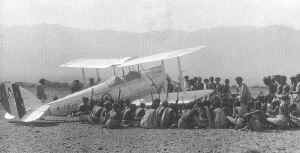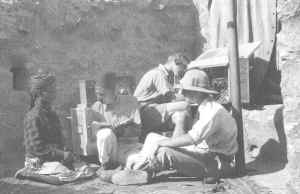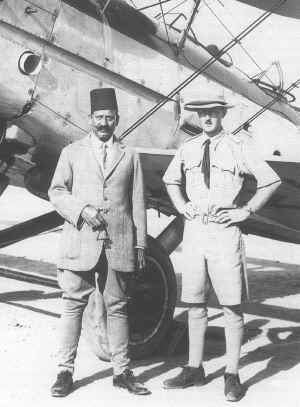Aubrey
Rickards:
winged pioneer
Wing Commander Aubrey Rickards (1898—1937)
holds a distinctive place in the annals of British penetration
of southern Arabia. But his role is not widely known; he did not
live to tell the tale. In 1937 he was killed in an air crash in
southern Oman. He was 39, and had already had an eventful
career, winning the Air Force Cross for gallantry in
Transjordan, and, as we shall see, the OBE. for services in
Aden.
Rickards was the son of a Gloucestershire farmer, and was a
student at the Royal Agricultural College, Cirencester, when the
First World War broke out. He enlisted in the Royal Flying Corps
and, after training as a pilot, was sent to France in 1917; a
fortnight later his plane was shot down and he spent the rest of
the war as a prisoner in Germany.
His post-war service in the Royal Air Force was spent mainly
in the Middle East, including seven years in Aden, and three
years in Iraq and the Gulf.
 |
The Tiger Moth
in which Rickards flew many sorties into the hinterland of
Aden.
Photograph: A R M Rickards; courtesy James Offer |
Rickards’ initial posting to Aden, as a Flight Lieutenant,
was from 1922—23. It whetted his interest in Aden’s little
known hinterland, and also in the Horn of Africa where he spent
several weeks on safari in Somaliland. In 1922, Ras Tafari,
later Emperor Haile Selassie, visited Aden, and it fell to
Rickards to give him his first experience of flying. The young
Prince Regent invited Rickards to visit Abyssinia. Three years
later Rickards found the opportunity to do so, organising and
leading a six month hunting and filming expedition through
western Abyssinia to the Sudan. He wrote a lively account of
this for The Sphere, which included a graphic description
of his close and nearly fatal encounter with a bull elephant.
In March 1928 Rickards returned to Aden [see
map] as RAF Intelligence
Officer and was to remain there for the next five years. His
arrival coincided with the assumption by the RAF of
responsibility for the defence of Aden and its Protectorate.
Since 1919, Imam Yahya, who claimed sovereignty over the whole
area, had refused to recognise the boundary between Yemen and
the Protectorate delimited by an Anglo-Turkish Commission in
1903—5, and his forces had steadily encroached on territory
claimed by the British. In the Dhala area, Zaidi encroachment
had reached a depth of 30 miles, bringing the nearest Zaidi post
to within 50 miles of Aden. Without massive military
reinforcements, the British in Aden were powerless to repel this
intrusion. However, the air power provided by the increased RAF
presence in 1928 (a squadron of 12 aircraft instead of a ‘flight’
of six) was soon to reverse the tide of Zaidi encroachment. In
February that year, the commander of the Zaidi garrison in Qa’taba
contrived the abduction of two shaikhs from within the
Protectorate. The British retaliated by bombing Zaidi border
garrisons until, in March, the two captives were released. A
temporary truce with the Imam followed, and Major (later Sir
Trenchard) Fowle, the Assistant British Resident, accompanied by
Sultan Abdul Karim Fadhl of Lahej, travelled overland to Taiz to
discuss a possible basis for a political settlement. Rickards
went with them as far as Musaimir on the border; Fowle had
wanted to take him all the way but thought that the presence of
an RAF officer might prove unwelcome to the Taiz garrison
commander, Ali al-Wazir. Later, the Imam asked for the truce to
be extended until the middle of July, to which the British
agreed on condition that the Imam’s forces evacuated Dhala by
20 June. The deadline passed, and warning leaflets dropped by
the RAF over Yemeni towns went unheeded. Bombing of Zaidi border
garrisons was resumed, and later extended to include military
targets in Taiz, Dhamar, Ibb and Yarim. This activity spurred
Qutaibi tribesmen to attack and expel the Zaidi post at Sulaik,
south of Dhala. Their success raised morale within the
Protectorate where previously panic had reigned due to rumours
of an imminent Zaidi advance on Lahej.
On 7 July Rickards was instructed to proceed to Sulaik to set
up a forward intelligence post and make contact with the Amir of
Dhala, Nasr bin Shaif. The latter had spent the past eight years
in exile in Lahej but was now mobilising a force of Amiri and
Radfani tribesmen to advance on Dhala under cover of the RAF. On
14 July the Amir, at the head of his improvised and turbulent
army of some thousand tribesmen, accompanied by Rickards with an
escort of fifty Lahej troops under the command of Ahmad Fadhl
Al-Abdali, succeeded in capturing Dhala.
Rickards and his W/T operator, Aircraftman Smith, installed
themselves in Dhala fort, where they were later joined by Hassan
Muhammad, a Residency interpreter sent up by Fowle to assist
Rickards in his intelligence and liaison role. By the end of
August. following the fall of Awabil to a mixed force of Shaibi
and Yafai irregulars, Zaidi forces had withdrawn from almost all
territory in and adjacent to Dhala. They had fought with
tenacity and resource, but could do little against the force
majeure of British air power.
Major Fowle (in his acting capacity as Resident) wrote to the
RAF Commander in Aden, Group-Captain Mitchell, on 15 July to
record his appreciation of Rickards’ services. Fowle noted
that ‘in addition to the Intelligence duties which he
performed for you, his W/T messages have been of great
assistance to me in keeping in touch with the political
situation, while his presence with the tribes, and his driving
power in getting them forward, have been very material factors
in their taking the town’. And in a letter to the Colonial
Secretary dated 8 September 1928, Sir Stewart Symes, the newly
arrived Resident, referred to the ‘remarkable daring and
discernment’ which Rickards had displayed during the Dhala
campaign, ‘ably helped’ by Hassan Muhammad. Rickards was
awarded the OBE, and among the few papers surviving from his
years in Aden are letters of congratulation from two leading
Adeni merchants: Karim Hasanali and F [Cowasjee] Dinshaw, both
of whom had interests on either side of the disputed border.
 |
Right to left:
Aubrey Rickards, Aircraftman A Smith, Hassan Muhamma and
local tribesman, Dhala Fort, 1928.
Courtesy: James Offer |
The air defence of Aden, and the strategic need for an air
link between Aden and Iraq, created a requirement for a
multiplicity of landing grounds to serve the comparatively short
range aircraft of those days. It was a requirement which
Rickards, harnessing his professional skills to his innate love
of travel and exploration, was well equipped to fulfil. He had
constructed a landing ground in Dhala in July 1928, and during
the next few years, travelling by air and overland to different
parts of the Protectorate, he surveyed and constructed most of
the 35 landing grounds used, or required for future use, by the
RAF. An allied objective of his surveys was to fill in blank
spaces on the map. As George Rentz wrote in The Middle East
Journal in 1951, ‘he sketched maps of what he saw from the
cockpit and quietly made notable contributions to geography’.
One of several sketch maps which Rickards made during his time
in Aden appeared in The Geographical Journal of March
1931, as an appendix to Squadron-Leader R. A. Cochrane’s
account of an air reconnaissance of Hadhramaut which he and
Rickards had undertaken in November 1929. Cochrane’s paper was
illustrated with photographs, taken by Rickards, of the region’s
striking lunar landscape. The Dutch traveller, Van Der Meulen,
acknowledged the help — air photographs, sketches and other
data — which he and Von Wissman had received from Rickards
during their first visit to southern Arabia in 1931, and Von
Wissman drew on this material in preparing his own celebrated
map of the region.
Towards the end of 1929, Rickards travelled by dhow from
Mukalla along the Mahra coast to Dhofar, and he is believed to
have made a further voyage along the coast the following year,
this time from Aden, to deliver a cargo of aviation fuel to
Salalah. In an article on Soqotra published in The Field in
May 1937, he refers to a journey which he had made to that
island on board a Sun badan; he revealed neither the date
nor other details of the voyage, but the article illuminates his
interest in local history and ethnography. In 1932 he travelled
from the coast of Hadhramaut to the interior to construct a
landing ground at Shibam; his film of this journey was later
shown at the Royal Geographical Society (RGS) but has yet to be
traced. The new landing ground at Shibam enabled the Resident in
Aden, Sir Bernard Reilly, to make an historic first visit to
Wadi Hadhramaut in 1933. Freya Stark also had reason to be
grateful to Rickards, for it was from Shibam that the RAF flew
her to hospital in Aden, after she had fallen seriously ill
during her travels in 1935. These were the subject of her
lecture to the RGS in December that year, which Rickards
attended, joining Cochrane and others in congratulating her
during the discussion afterwards.
According to Philby, who visited the region in 1936, Rickards
also explored Wadi Duhr and Wadi ‘Irma, at the western end of
Wadi Hadhramaut, before proceeding south of Shabwa and westwards
to Nisab. Philby added that Rickards’ death in 1937 had left
‘a regrettable gap in the ranks of Arabian exploration: the
airman has but slender opportunities of constructive work in
Arabia, but he [Rickards] was certainly one who made the most of
such chances as came his way and fully earned a place on the
roll of those who have contributed to our knowledge of a still
little-known country’.
 |
The
Amir of Dhala (centre, front row), HH Sultan Abdul Karim
Fadhl between him and the British Resident, Sir Stewart
Symes, Lahej, 1930.
Courtesy: James Offer |
In 1931 Rickards accompanied Lord Belhaven and Colonel M. C.
Lake on a Journey from Nisab to Beihan. This was Belhaven’s
first meeting ‘with a remarkable personality.., his knowledge
of the country and of its customs was encyclopaedic ...’
Belhaven reproduced several of Rickards’ photographic studies
of Beihani tribesmen in his Kingdom of Melehior (1949),
and in this and his later memoir, The Uneven Road (1955),
he has left us with a vivid portrait of a man he greatly
admired:
‘he was of medium height and capable of great physical
endurance. I shall not forget his reddish hair and bright blue
eyes, his sharp sense of humour, and the easy confident
carriage of his shoulders ... he had the trust of the Arabs to
a degree which I have not seen surpassed, despite his lack of
Arabic, which he spoke with a minute vocabulary and a
confusing disregard for grammar. It was hard to tell which,
between him and Lake, had a better knowledge of the country.
Rickards had method in finding and retaining information,
while Lake was unmethodical and reluctant to impart what he
had learned ... With Rickards all was shared. He never failed
to visit me on his return from his many expeditions, bringing
with him maps and photographs and all his official reports ...
When Rickards died in an air accident, what fire and light
perished!’
The poignant story of the death of Rickards and his two
companions, Pilot Officer McClatchey and Aircraftman O’Leary,
when their RAF Vincent crashed at Khor Gharim in October 1937;
of their makeshift burial beside that desolate creek on the
southern coast of Oman; of their reburial in Muscat some sixty
years later, has been told in detail by Cohn Richardson in his
book Masirah: Tales from a Desert Island (2001). The
accident occurred during Rickards’ second posting to Iraq
after leaving Aden, this time attached to RAF, Basra, but based
in Bahrain, with liaison duties covering the Gulf. Suffice it to
say here that Rickards’ two daughters, who had lost their
father in childhood, his nephew, niece and grandson were able to
attend the reburial service held at the Christian Cemetery,
Muscat, in May 1998.
When news of Rickards’ death reached Sultan Abdul Karim
Fadhl of Lahej, ruler of the most influential state in the
western half of the Protectorate, he wrote to the Governor of
Aden asking for his condolences to be conveyed to Rickards’
family. These were gratefully acknowledged by Rickards’ widow,
Anna, and his father, Robert. The Sultan’s regard for
Rickards, and regret at his passing, will have been shared by
many others in southern Arabia and beyond.
JOHN SHIPMAN
The Editor is grateful to Mr James Offer, nephew of the late
Wing Commander Rickards and trustee of his papers, for his
invaluable assistance, and for permitting publication of the
photographs.

|
Rickards
with HH Sultan Umar bin Awadh al-Qu-aiti, ruler of the
Hadhrami State of Shihr and Mukalla, c 1930.
Courtesy: James Offer |
July 2002
|
